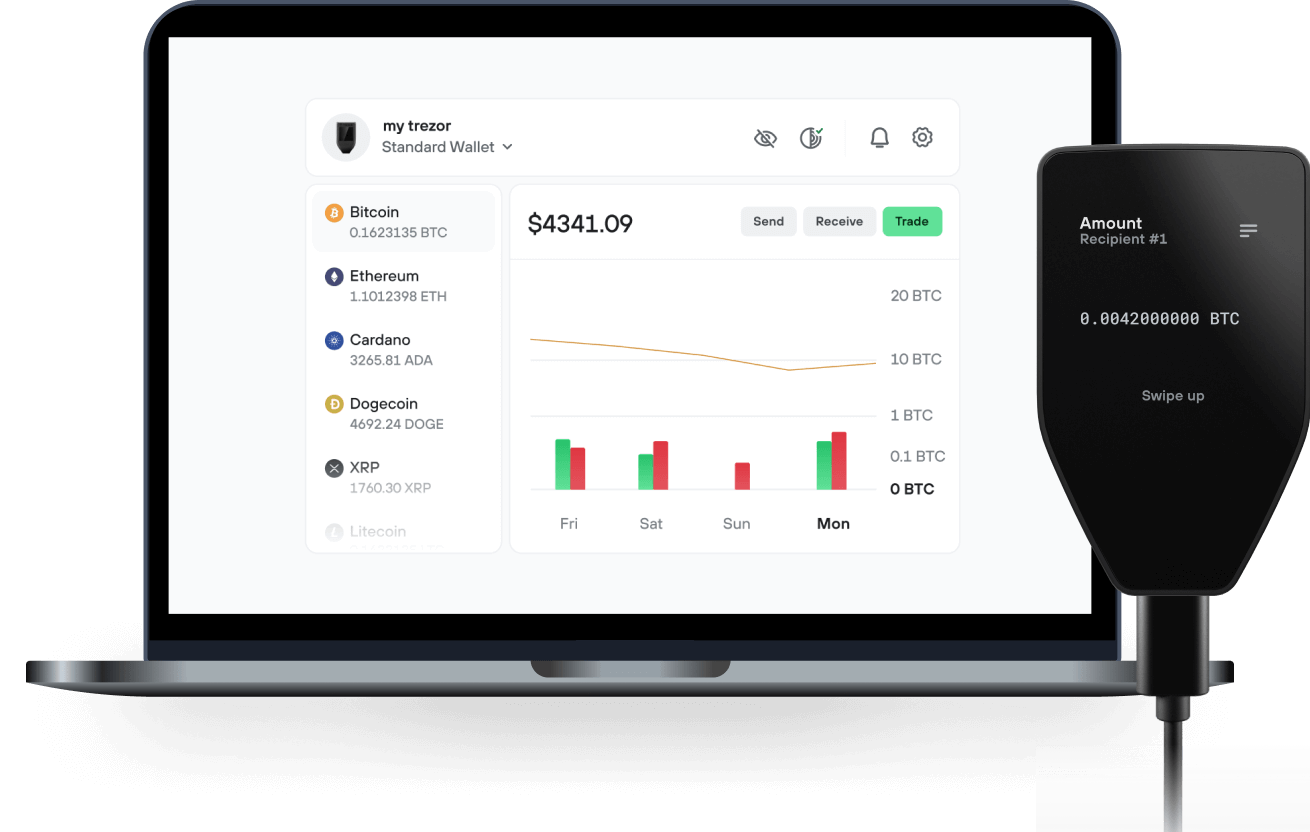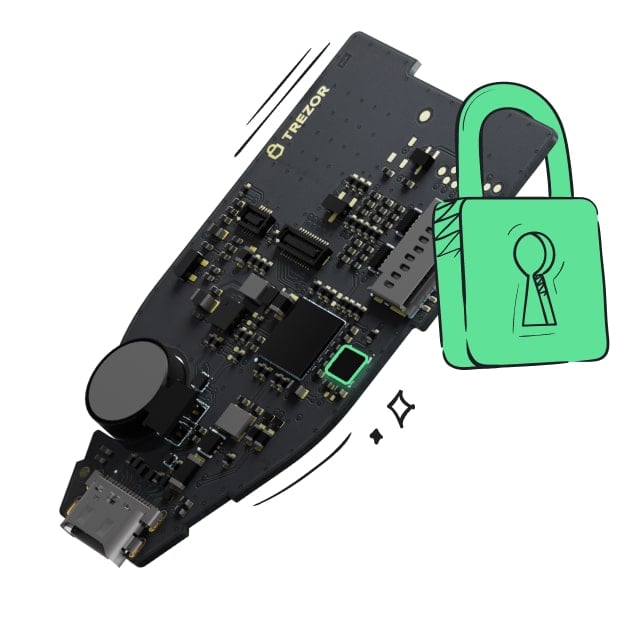Portefeuille sûr et sécurisé Litecoin
Prenez le contrôle de vos Litecoin actifs en toute confiance dans l’écosystème Trezor.
- Sécurisé par votre portefeuille matériel
- Utiliser avec des hot wallets compatibles
- Adopté par plus de 2 millions de clients

Achetez, vendez et gérez vos Litecoin avec l'application Trezor Suite

Envoyer et recevoir

Achetez, vendez et échangez
Portefeuilles matériels Trezor qui supportent Litecoin
Synchronisez votre Trezor avec des applications de portefeuille
Gérez vos Litecoin avec votre portefeuille matériel Trezor synchronisé avec plusieurs applications de portefeuilles.
Trezor Suite
Exodus
Litecoin Réseau supporté
- Litecoin
Pourquoi un portefeuille matériel ?
Allez hors ligne avec Trezor
- Vous possédez 100% de vos crypto
- Votre portefeuille est 100% sécurisé hors ligne
- Vos données sont 100 % anonymes
- Vos cryptos ne dépendent d’aucune entreprise
Échanges en ligne
- Si un échange échoue, vous perdez vos crypto
- Les échanges sont des cibles pour les pirates
- Vos données personnelles peuvent être exposées
- Vous ne possédez pas réellement vos crypto
Comment utiliser LTC sur Trezor
Connectez votre Trezor
Installez l'application Trezor Suite

Transférez votre LTC

Profitez pleinement de votre LTC
Trezor garde vos LTC en sécurité
 Protégé par Élément Sécurisé
Protégé par Élément SécuriséLa meilleure défense contre les menaces en ligne et hors ligne
 Vos jetons, votre contrôle
Vos jetons, votre contrôleContrôle absolu de chaque transaction avec confirmation sur l'appareil
 La sécurité commence par le code ouvert
La sécurité commence par le code ouvertLe design de portefeuille transparent rend votre Trezor meilleur et plus sûr
 Sauvegarde de portefeuille claire et simple
Sauvegarde de portefeuille claire et simpleRécupérez l’accès à vos actifs digitaux avec un nouveau standard de sauvegarde
 Confiance depuis le premier jour
Confiance depuis le premier jourLes sceaux de sécurité sur l’emballage et l’appareil protègent l’intégrité de votre Trezor
Litecoin for speed & security
- Litecoin network benefits
- Litecoin's network offers faster transaction times compared to Bitcoin, with block generation occurring every 2.5 minutes, ensuring quicker confirmations and reduced network congestion. This makes Litecoin ideal for daily transactions and micro-payments.
- Utilizing a similar proof-of-work consensus mechanism as Bitcoin, Litecoin benefits from a highly secure and decentralized network, making it resistant to fraud and attacks. Its established blockchain is one of the oldest in the industry, contributing to long-term stability.
- Litecoin's network is designed to handle a higher volume of transactions, enabling scalability even as adoption increases. This makes Litecoin an attractive option for increasing numbers of users, merchants, and developers.
- Secure Litecoin management
- Trezor Suite provides a seamless interface for managing Litecoin and other cryptocurrencies. The app supports multi-currency wallets, making it easy for users to store, send, and receive Litecoin securely from one platform.
- As a wallet app, Trezor Suite offers top-tier security, including two-factor authentication (2FA), PIN protection, and wallet backup options. It ensures that users' private keys are stored offline, safeguarding against online threats like hacking.
- Trezor Suite is compatible with both desktop and mobile devices, offering flexibility in managing Litecoin assets on the go. Users can easily track balances, view transaction history, and initiate transfers from various devices.
- Third-party wallet apps
- Exodus provides an intuitive wallet interface for managing Litecoin alongside a variety of other cryptocurrencies. It integrates directly with Trezor hardware wallets, enhancing security while offering a user-friendly experience with real-time price tracking, portfolio management, and in-app exchanges.
- Wallet apps like Exodus offer multi-platform support, including Windows, Mac, Linux, and mobile devices. This ensures Litecoin users can manage their assets from virtually anywhere.
Litecoin in a nutshell
Litecoin (LTC), created by Charlie Lee in October 2011, is one of the first altcoins and operates as a peer-to-peer cryptocurrency. It runs on an open-source blockchain, similar to Bitcoin, and uses a proof-of-work (PoW) consensus mechanism. Litecoin enables fast, low-cost transactions with quicker block generation times, resulting in faster transaction confirmations. Its total supply is capped at 84 million LTC.
Litecoin is supported directly in the Trezor Suite and Trezor Suite Lite apps.
Communautés
Questions fréquemment posées
Le Litecoin est miné avec un algorithme proof-of-work appelé Scrypt, différent de l’algorithme SHA-256 utilisé pour le Bitcoin. Les mineurs valident les transactions et créent de nouveaux blocs en résolvant des problèmes mathématiques complexes, ce qui leur permet de recevoir des LTC fraîchement minés ainsi que les frais liés aux transactions.
Un portefeuille Litecoin est un outil qui vous permet d’envoyer, de recevoir et de stocker des LTC. Il peut s’agir d’un portefeuille matériel, comme Trezor, d’un portefeuille logiciel sur ordinateur ou appareil mobile, ou même d’un portefeuille papier.
Un explorateur Litecoin est un outil en ligne qui vous permet de consulter les détails des transactions, des blocs et des adresses sur la blockchain Litecoin. Il est utile pour vérifier les transactions et consulter les soldes.
Le hashrate du Litecoin mesure la puissance de calcul totale utilisée pour effectuer le minage et traiter les transactions sur le réseau Litecoin. Ce taux varie en fonction du nombre de mineurs actifs et de l'efficacité de leur matériel de minage.
Un hashrate élevé signifie un réseau plus sécurisé, car cela indique que davantage de ressources sont mobilisées pour vérifier les transactions et prévenir les attaques. À l’inverse, un hashrate faible peut indiquer une baisse de l’activité de minage, ce qui pourrait affecter la sécurité et la rapidité des transactions.
Le hashrate peut être influencé par des facteurs tels que la difficulté de minage, les conditions du marché et les améliorations du matériel de minage. Surveiller le hashrate permet d’évaluer la santé globale du réseau Litecoin.
Le Litecoin peut être utilisé pour des paiements en ligne ainsi que dans les magasins physiques qui acceptent les cryptomonnaies. Comme pour toute autre cryptomonnaie, vous devrez envoyer le montant nécessaire de LTC à l’adresse de réception du destinataire. Les transactions sont généralement plus rapides et moins coûteuses qu’avec le Bitcoin.
Litecoin est davantage axé sur les transactions de pair à pair, tandis qu'Ethereum permet aussi les contrats intelligents et les applications décentralisées. Ils utilisent des algorithmes différents, ont des temps de bloc différents et remplissent des rôles distincts au sein de l’écosystème crypto.
Si vous cherchez à stocker et gérer vos Litecoin en toute sécurité, Trezor est un excellent choix. C'est l'un des meilleurs portefeuilles matériels disponibles, offrant une sécurité optimale en conservant l'accès à vos LTC hors ligne, à l'abri des piratages et des logiciels malveillants.
Avec l'application Trezor Suite, vous pouvez facilement envoyer, recevoir et gérer vos Litecoin, le tout via une interface très intuitive et des fonctionnalités de sécurité robustes. Si vous souhaitez véritablement protéger vos crypto, Trezor figure sans aucun doute parmi les meilleurs portefeuilles pour Litecoin.
La façon la plus sûre d’acheter des LTC avec votre Trezor est de passer par l’application Trezor Suite, et c’est très simple à faire en quelques étapes seulement ! Rendez-vous dans l’onglet « Acheter & vendre » de Trezor Suite, saisissez le montant de monnaie fiduciaire que vous souhaitez dépenser, puis sélectionnez un échange de confiance partenaire d’Invity.io. Vous pouvez finaliser votre achat rapidement et en toute sécurité, ce qui vous donne un contrôle total sur vos LTC.
Litecoin se concentre sur des transactions rapides de pair à pair, offrant des délais de confirmation plus courts avec un temps moyen de bloc d'environ 2,5 minutes. En comparaison, Ethereum prend en charge les contrats intelligents et les applications décentralisées (DApps), permettant aux développeurs de créer une grande variété d'applications sur sa blockchain, avec un temps moyen de bloc d'environ 12 à 15 secondes.
Ils utilisent également des algorithmes différents : Litecoin utilise un système de proof-of-work basé sur Scrypt, tandis qu'Ethereum passe au proof-of-stake. Globalement, Litecoin est idéal pour des transactions rapides, tandis qu'Ethereum offre une plateforme polyvalente pour l'innovation.